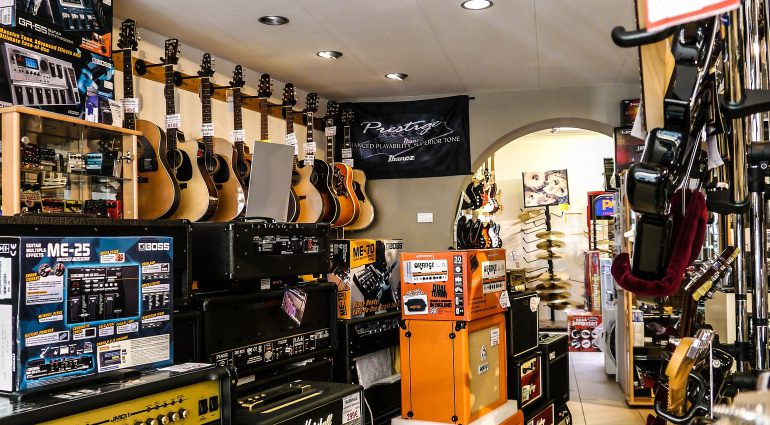Why you’re waiting longer and paying more for your gear in 2022
If you’ve been shopping around for a guitar, synth or… well, pretty much anything else lately, chances are you’ve found yourself standing in front of an empty shelf, or looking at an “out of stock” label on a web shop. Cars, sofas, guitars, synths, audio gear: it’s getting hard to come by when we want it. Here’s why.
Before Covid, manufacturing your favourite music gear – like pretty much any other factory-produced commodity – was a just-in-time operation. A company, say, a guitar maker, orders the components it needs to arrive when production is planned. That’s way more efficient than stockpiling things needed to make the product. The whole global manufacturing machine was working away, all those cogs and wheels of all those factories spinning in harmony to make all those products.
Covid-19
And then Covid struck. Around February 2020, a lot of factories shut down, stopping production in its tracks. Meanwhile, a lot of people were spending a lot of time at home. Guitar-curious people – wallets swelled by lower costs (no social life, no holidays) – decided to pursue their dream of owning their first instruments. Many of us with existing collections decided that, hell, now’s a good time as any to get another one. Time to finish writing that concept album! As the pandemic forced companies to shut down production, demand was soaring.
Here’s what manufacturers say
Online sales boomed, with increased demand stretching well into 2021. But by now, stocks of some gear seemed to be running dry. I talked to several people in the industry very familiar with manufacturing and sales. They all had hair-raising stories to tell. One manager recounted a guitar model that couldn’t be shipped because there were no strings available. Another recounted how his company had paid $100 per unit for a consignment of chips that normally cost $7.
We also reached out officially to several manufacturers about their experiences and sales for 2021. Andy Mooney, Fender’s CEO, said in response to our inquiry, that FMIC, Fender’s parent company, was reporting a doubling of sales since before the pandemic. For 2021, the company expects to report an incredible 30% rise in revenues. All the manufacturers we spoke to, including PRS Guitars, IK Multimedia, Behringer and Vintage Guitars, said they had experienced enormous demand that they were trying hard to keep up with.
After manufacturing started up again post-lockdown and economies re-opened, some components had become hard to come by. Suddenly, our little musical instruments industry was competing with car makers for chips, with shipbuilders for metals. “Not only the MI industry is affected by chip and component shortages but also, for example, the automotive, gaming, home entertainment, medical devices and computing industries,” reports Tiia Hassinen from IK Multimedia. “The scarce resources must be shared between all of them, and the price of many components has also skyrocketed.” Some factories were even hit by power shortages, further slowing production.
Sitting on the dock of the bay
Another factor that has sales and distribution staff tearing their hair out is containers. Getting your wares from a factory in East Asia pre-pandemic was easy, shipping containers were plentiful. But with the rise in demand for music products, factories are getting buried in orders. “We have had to increase production at our factories to cope with the added demand, and we have seen some gaps in our range compared to ‘normal’ years,” says Paul Smith from Vintage Guitars’ parent company JHS. “For 2022 we have further increased our production capacities to enable us to cope with the anticipated continuation of demand worldwide.”
And even if all the parts are available, thousands of finished guitars and synths were (and are) sitting dockside, waiting for a container. A well-placed industry insider I talked to showed me a picture of office space at a guitar factory, with packaged guitars stacked up to the ceiling around desks in the admin wing. There wasn’t anywhere else to put them.
Shipping Container Crisis is hitting MI hard
It used to cost around $2100 to hire a 40-foot container to ship products from China to Europe. Now it costs up to $14,000. And that is simply because the huge demand in containers is global. Everywhere, manufacturers are trying to cope with surges in demand. That’s plugging up key areas in ports. Even when the ship carrying your guitar to the dealer you buy it from is on its way, it often has to wait in a holding space outside its destination for days before a berth becomes free and the freight is unloaded.
And the picture is not brightening heading into 2022. PRS Director of Sales, Jim Cullen: “There have also been supply chain disruptions, and they are changing daily. We are seeing this especially with amplifiers. It is a juggling act, but we have fantastic global relationships, and we are tenacious and diligent with our goals in an effort to keep the ship moving forward and our customers happy.” It must feel like whack-a-mole: one supply problem is solved, boom, another crops up. Managed to secure a supply of strings for that new guitar model? Guess what, the factory is now forced to shut down due to energy rationing in some parts of Asia, to save electricity. That might mean another months-long delay getting your product to market.
More demand is better, right?
So, a massive jump in earnings was felt across the industry. But how big was it? Fender reports an estimated 30% increase; PRS around 18-20%. Vintage Guitars reported a doubling of demand in 2021, while IK Multimedia told us it was experiencing growth but declined to give us a number.
If you’re shopping around for music gear, bear in mind that you’re probably going to be paying more. When component and shipping costs rise, prices will too. And we’re part of a global picture here. The musical instruments industry is a drop in the world economy’s ocean, but all sectors are facing the same problems of rising costs. That’s forcing up prices everywhere, leading to inflation all over the world. And the pandemic is entering a new phase, with many firms hit by staff absences due to Omicron.
So, it’s a perfect storm. Demand is up, leading to scarcity of components as well as difficulties in getting guitars, synths and other audio gear to expectant customers, who are paying more for their products. Have you noticed products being unavailable or delayed, or any price increases over the last few months? Let us know your experiences in the comments below.
10 responses to “Why you’re waiting longer and paying more for your gear in 2022”
 4,7 / 5,0 |
4,7 / 5,0 | 








This is a very interesting article however I disagree with the opening statement it is fundamentally wrong, what was written here in this article.
As a business owner and a professional in the music industry in a major city in the United States, the true and best way is to have a warehouse stockpiled full of parts especially if these are the instruments or products that you make on a regular basis. Because every business owner knows a interruption in their supply chain will affect production of their livelihood.
In fact the only companies really thriving are the ones who thought ahead and had a stock pile of parts, they were able to continue making existing products or release their new ones.
Actually, it’s common sense.
Unfortunately some of these companies had a very incomplete business model and they we’re stuck and could not move forward.
However companies and countries are now learning diversification in manufacturing. Everybody put their eggs in one basket and now look what happened.
>think local and self-sufficient.
OK as you were… Thank you for reading.
While I agree with what you’re saying and believe that’s how companies should run, a lot of companies operate using the JIT (just in time) model. JIT reduces costs tremendously until supplies run short and factories catch on fire.
You have enough gears. Save your money and release stuff.
One of the other agitating dynamics is how eager sellers are to take “pre-orders” or even advertise as “In Stock” or “on the way” when knowing that they cannot fill them anytime soon.
I have been waiting on Korg to release the Wavestate SE for over a year.
Unfortunately politics have intersected as well. Inflation is reported at just over 7% but some economists thing the true number is more than double. Paying people to stay home during Covid only increased demand while supply dwindled. The high prices are here to stay. Fender instruments increased in msrp $100 first weeknin January (for instance, a mustang bass i wanted went up from $750 to $850 at SW which is over 13% increase.)
Lets be sober here, these prices aren’t going to go down when supply chains recover, the new inflated gear prices are here to stay.
Interestingly, the cost to buy gear is furthered in some specific areas, when considering the cost to return items, as brick and mortars are all but dead in most of the country (barring cities like Austin and Nashville that have a stronger brick mortar retail market). Now it essentially costs money to try an acoustic guitar out because you have to pay to return ship.
Tough days for gear-heads.
Good points. After working in retail here in Los Angeles I understand the whole retail supply chain especially in musical instruments.
Ok you have the MSRP price which is the pie in the sky price .. then you have the MAP price, so basically there’s a 30 to 40% mark up on everything in the industry compared to the end column pricing straight out of the manufacturer or distribution sales network. so I guess it will become more competitive soon, the higher prices will come down a little, retailers are the biggest problem.
Sales people who have very little education or knowledge and can articulate and translate honestly to the customer.. this is the problem as well. Streaming video personalities who are fanboys for a retailer or a manufacturer are also the problem.
In Los Angeles, there are a lot of brick and mortar as you can go into and try out guitars lot of boutiques.
And here’s the point it’s not really consumers versus sales in manufacturing. It’s a symbiotic relationship consumers are 100% reliant and do not set prices. So the industry needs to clean itself up. All of those Legacy fools, fossils and stalactites who figure every way to cheat the consumer … Pack it up Stan!
That mustang Guitar, still could have sold for $750 and the retailer would’ve made a good 20 points on that.
Retailer, you have to proved that you bought this piece of gear after the supply chain conundrum… Everybody piles on and says chip shortage /high price, but they can’t prove that chip is actually purchased before or after the chip shortage. You can’t surcharge the chip that was produced before chip shortage and inflate its price that’s unethical.
A written observation, Not a rant.
“You can’t surcharge the chip that was produced before chip shortage and inflate its price that’s unethical.”
People will sell things at the price people are willing to pay for them. That’s business. Unfortunately, in the real world, ethics never made anybody a fortune. And money talks.
We said a while back that the ‘golden era’ of cheap hardware was 2010 – 2021. It was never going to go on forever. Several reasons, cheap imports into the West, low wages and inflation keeping retail prices down, the ubiquity of great VSTs that can do the job of hardware, and the notion (until around 2015) that hardware was going out of fashion for good. Good examples of things being much cheaper than normal might be the FA-06, the Deepmind, the Monologue etc which in different circumstances would have cost much more. There’s still a lot of quality, cheap hardware available today but it won’t last forever. If you bought cheap hardware 2010-2021 you’ll likely get more than you paid for it when you sell it on (in a year or 2)
I want a Guild D-40. Been waiting for a while. But I’m used to getting a good price. I’m certainly not going to pay advertised price. I have no trouble waiting for the logistics issues to be resolved. Hopefully that will be soon.
You are currently viewing a placeholder content from Facebook. To access the actual content, click the button below. Please note that doing so will share data with third-party providers.
More InformationYou are currently viewing a placeholder content from Instagram. To access the actual content, click the button below. Please note that doing so will share data with third-party providers.
More InformationYou are currently viewing a placeholder content from X. To access the actual content, click the button below. Please note that doing so will share data with third-party providers.
More Information